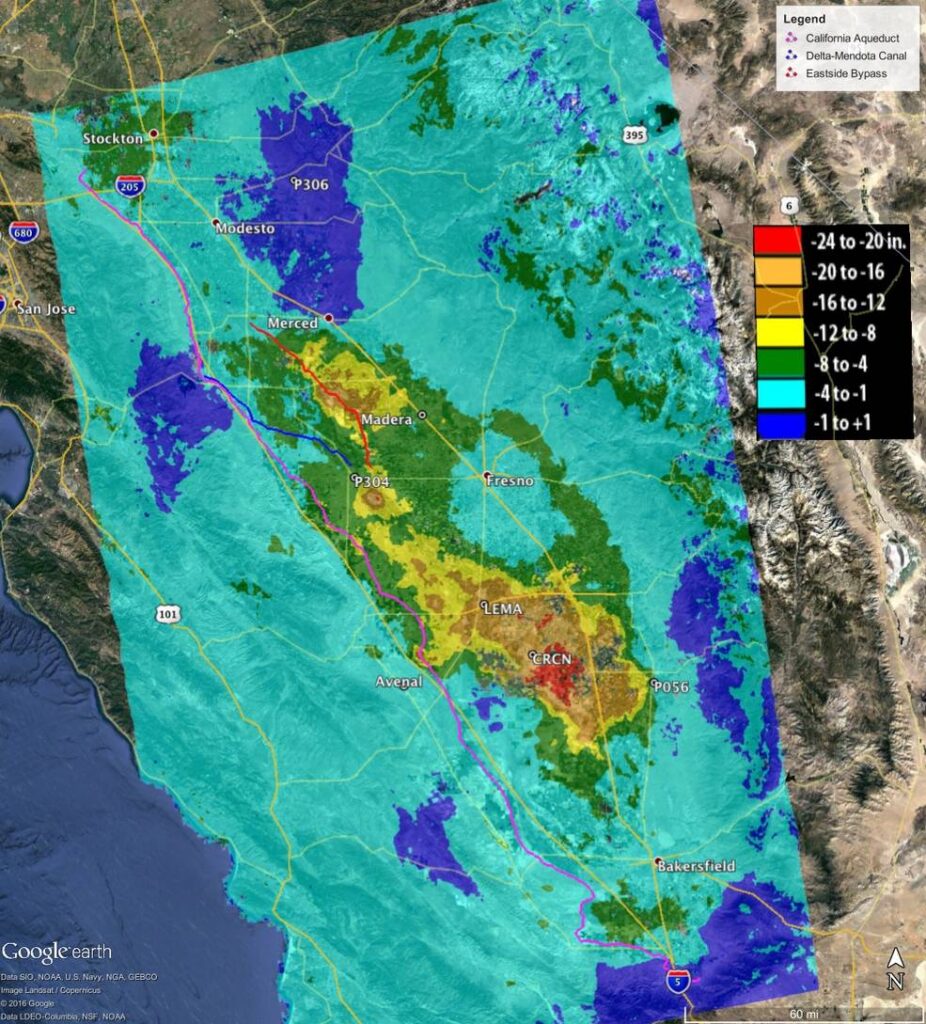Scientists have figured out how to more accurately understand ground fluctuations in the San Joaquin Valley. It’s hoped the research will eventually become a tool valley water managers can use to predict the effects of groundwater pumping.
Up until now, researchers have used satellite technology to collect data on changing ground levels, which can tell them about the conditions of groundwater levels.
But there was a complication. Groundwater pumping wasn’t the only reason the ground was shifting. The sheer mass of snowpack in the Sierra Nevada mountains during winter months also caused changes in the ground on the valley floor.
Scientists at Stanford University have come up with a way to separate the two types of deformation in a new study.
Overpumping groundwater in the valley has caused compaction in the lower aquifer which results in subsidence, land sinking. Some areas of the valley have subsided so badly, it has damaged vital infrastructure. A 33-mile section of the Friant-Kern Canal, which runs from Fresno south to Arvin, had sunk because of overpumping. That “sag” has limited the canal’s carrying capacity by 60%.
Scientists have been able to better understand changes in groundwater levels by using interferometric synthetic aperture radar, or InSAR, which uses satellite radar waves to measure how much the earth’s surface has sunk or bulged to determine how water moves underground.
There are also seasonal patterns to changing ground levels, said Rosemary Knight, a George L. Harrington Professor of Earth Sciences at Stanford University. Groundwater typically drops in summer when pumping intensifies and rebounds in winter when there is recharge, she said.
Changes caused by snowpack, however, don’t follow the same pattern.
“The timing is the exact opposite of the groundwater system,” said Knight. “In the summer, groundwater pumping would move the ground surface down, the melting of the snow and ice would move the ground surface up. So clearly, you need to correct for the component of the deformation that’s due to the snow and ice in order to accurately estimate the changes in the water levels.”
Knight and Seogi Kang, lead author of the study, analyzed the deformation data and were able to separate it into different classes based on how the changes were happening over time.
“Once you do that, you can start pulling apart the total deformation that you’re seeing and recognize in places in the valley, this dominant signature due to the snow and ice in the Sierras,” said Knight. “That allows you to come up with a mathematical description of the deformation due to the snow and ice that you can then use to correct or you can then use to remove that component from the total deformation everywhere in the valley.”
Using machine learning, they could distinguish different behaviors in the data, said Kang.
Most people assumed the groundwater pumping effect would “dominate” as the cause of deformation, said Kang.
“But there are many other locations in the valley where that is not the dominant effect,” said Kang. “And people didn’t realize that. That was actually a surprise to us.”
The data provided from the study can be used by groundwater managers to monitor the health of the groundwater system and the consequences of overpumping, said Knight.
Going forward, research on InSAR and deformation is essentially complete, said Knight. The products being created out of this data are, “exceptional” she said.
What is needed is a better understanding of the link between pumping at certain locations in the valley and the resulting subsidence and surface level changes, Knight said.
“The relationship requires a much better understanding of subsurface materials and how they respond to changing water levels,” said Knight. “We need to be able to provide groundwater managers with the modeling tools that they need to have accurate predictions as to what long term subsidence is likely to be under various scenarios of climate change, and groundwater pumping.”
Share this:
- Click to share on Facebook (Opens in new window)
- Click to share on Twitter (Opens in new window)
- Click to share on LinkedIn (Opens in new window)
- Click to share on Reddit (Opens in new window)
- Click to share on Tumblr (Opens in new window)
- Click to share on Pinterest (Opens in new window)
- Click to share on Pocket (Opens in new window)
- Click to share on Telegram (Opens in new window)
- Click to share on WhatsApp (Opens in new window)
- Click to print (Opens in new window)








